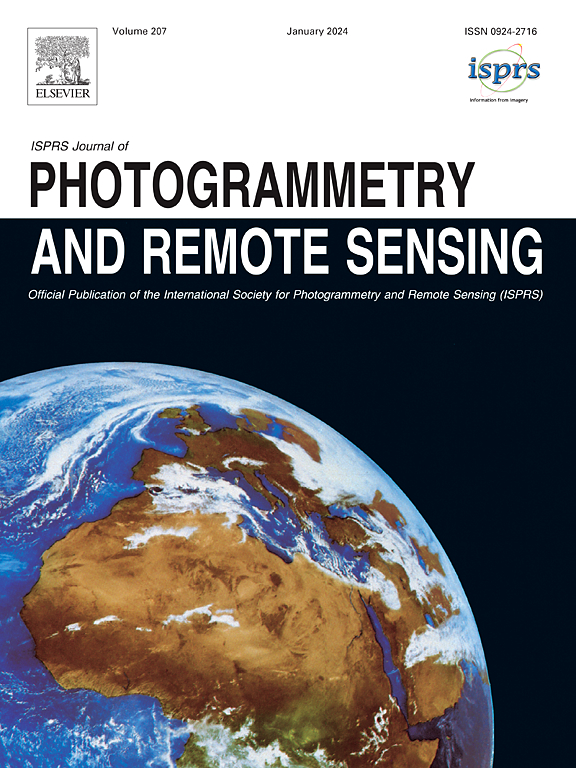Time series sUAV data reveal moderate accuracy and large uncertainties in spring phenology metric of deciduous broadleaf forest as estimated by vegetation index-based phenological models
IF 10.6
1区 地球科学
Q1 GEOGRAPHY, PHYSICAL
ISPRS Journal of Photogrammetry and Remote Sensing
Pub Date : 2024-09-24
DOI:10.1016/j.isprsjprs.2024.09.023
引用次数: 0
Abstract
Accurate delineation of spring phenology (e.g., start of growing season, SOS) of deciduous forests is essential for understanding its responses to environmental changes. To date, SOS dates from analyses of satellite images and vegetation index (VI) −based phenological models have notable discrepancies but they have not been fully evaluated, primarily due to the lack of ground reference data for evaluation. This study evaluated the SOS dates of a deciduous broadleaf forest estimated by VI-based phenological models from three satellite sensors (PlanetScope, Sentinel-2A/B, and Landsat-7/8/9) by using ground reference data collected by a small unmanned aerial vehicle (sUAV). Daily sUAV imagery (0.035-meter resolution) was used to identify and generate green leaf maps. These green leaf maps were further aggregated to generate Green Leaf Fraction (GLF) maps at the spatial resolutions of PlanetScope (3-meter), Sentinel-2A/B (10-meter), and Landsat-7/8/9 (30-meter). The temporal changes of GLF differ from those of vegetation indices in spring, with the peak dates of GLF being much earlier than those of VIs. At the SOS dates estimated by VI-based phenological models in 2022 (Julian days from 105 to 111), GLF already ranges from 62% to 96%. The moderate accuracy and large uncertainties of SOS dates from VI-based phenological models arise from the limitations of vegetation indices in accurately tracking the number of green leaves and the inherent uncertainties of the mathematical models used. The results of this study clearly highlight the need for new research on spring phenology of deciduous forests.
基于植被指数的物候模型估算的落叶阔叶林春季物候指标的时间序列 sUAV 数据显示出中等精度和较大的不确定性
准确划分落叶林的春季物候(如生长季节的开始,SOS)对于了解其对环境变化的反应至关重要。迄今为止,通过分析卫星图像和基于植被指数(VI)的物候模型得出的 SOS 日期存在明显差异,但尚未对其进行全面评估,主要原因是缺乏用于评估的地面参考数据。本研究利用小型无人飞行器(sUAV)收集的地面参考数据,评估了基于植被指数的物候模型通过三种卫星传感器(PlanetScope、Sentinel-2A/B 和 Landsat-7/8/9)估算的落叶阔叶林的 SOS 日期。小型无人飞行器的每日图像(0.035 米分辨率)用于识别和生成绿叶地图。这些绿叶图经过进一步汇总,生成了空间分辨率分别为 PlanetScope(3 米)、Sentinel-2A/B(10 米)和 Landsat-7/8/9(30 米)的绿叶比例(GLF)图。GLF 的时间变化与春季植被指数的时间变化不同,GLF 的峰值日期比 VIs 的峰值日期要早得多。在 2022 年基于 VI 的物候模型估计的 SOS 日期(朱利安日从 105 天到 111 天),GLF 已达到 62% 到 96%。由于植被指数在准确跟踪绿叶数量方面的局限性和所使用数学模型的固有不确定性,基于VI的物候模型估算的SOS日期的准确性一般,不确定性较大。这项研究的结果明确强调了对落叶林春季物候进行新研究的必要性。
本文章由计算机程序翻译,如有差异,请以英文原文为准。
求助全文
约1分钟内获得全文
求助全文
来源期刊

ISPRS Journal of Photogrammetry and Remote Sensing
工程技术-成像科学与照相技术
CiteScore
21.00
自引率
6.30%
发文量
273
审稿时长
40 days
期刊介绍:
The ISPRS Journal of Photogrammetry and Remote Sensing (P&RS) serves as the official journal of the International Society for Photogrammetry and Remote Sensing (ISPRS). It acts as a platform for scientists and professionals worldwide who are involved in various disciplines that utilize photogrammetry, remote sensing, spatial information systems, computer vision, and related fields. The journal aims to facilitate communication and dissemination of advancements in these disciplines, while also acting as a comprehensive source of reference and archive.
P&RS endeavors to publish high-quality, peer-reviewed research papers that are preferably original and have not been published before. These papers can cover scientific/research, technological development, or application/practical aspects. Additionally, the journal welcomes papers that are based on presentations from ISPRS meetings, as long as they are considered significant contributions to the aforementioned fields.
In particular, P&RS encourages the submission of papers that are of broad scientific interest, showcase innovative applications (especially in emerging fields), have an interdisciplinary focus, discuss topics that have received limited attention in P&RS or related journals, or explore new directions in scientific or professional realms. It is preferred that theoretical papers include practical applications, while papers focusing on systems and applications should include a theoretical background.
 求助内容:
求助内容: 应助结果提醒方式:
应助结果提醒方式:


